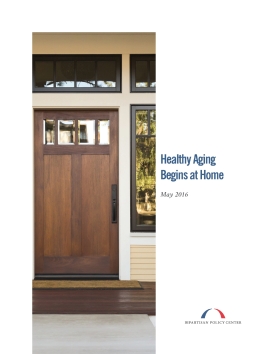It wasn’t all that along ago that remaining in our homes as we grew older was a natural and expected thing to do. Independent and assisted living, memory care, naturally occurring retirement communities and “villages” simply did not exist or were in their infancy. Fast forward to today where there are a myriad of choices for living out our old age. But we have now come full circle as one of the highest trending topics  in the senior living realm is “aging in place” or “aging at home.” (The World Health Organization has coined the term “ageing in the right place,” which I think is highly appropriate.)
in the senior living realm is “aging in place” or “aging at home.” (The World Health Organization has coined the term “ageing in the right place,” which I think is highly appropriate.)
The just-released Bipartisan Policy Center (BPC) report titled Healthy Aging Begins at Home makes 30 recommendations that federal and state governments can investigate and implement to improve access to quality housing for seniors. While there are no easy solutions, the report does attempt to identify some, but seems to ignore others.
Howard Gleckman, a much-respected and favorite author of mine on aging, has written a stunning article titled, “To Stay in Their Communities, Seniors First Need a Place to Live” that is both a commentary and critique on this report. In his article he notes that the recommendations target increasing the number of government subsidized rental units for low-income seniors and encourage local governments to become more flexible in housing options. For example, local housing codes can restrict more than one home on a property, the number of people living in a property and alternatives such as so-called “granny apartments” within a family home.
He also takes the BPC to task for not acknowledging that there are many seniors who are not “poor enough” to take advantage of government housing programs. This “stuck in the middle” sector can’t afford to move, but cannot (or should not) remain in their home either. The high cost of home maintenance and increasing property taxes, lack of access to transportation or even a structure that is unsafe could dictate that they should move to another home. But if there is no affordable housing for them to choose from, they are literally trapped. There simply is not enough housing stock for this segment of the population.
If you add to this already difficult situation the fact that such housing should also be universally designed to accommodate the physical limitations of the aging adult or less abled person, and the situation becomes even more dire. Common structure features can turn into barriers for some, such as stairs, inappropriate lighting, cabinets that are too high, floor coverings that give off glare or are too slippery or even homes with no bedroom on the first floor make an otherwise “normal” home an unacceptable one.
And Gleckman notes that, for example, offering tax breaks as suggested in the BPC report could encourage some older adults to remain in their homes when, in fact, it is not the best option for them for a whole host of reasons. But, again, are there acceptable possibilities that could override this notion, such as affordable apartments in an “urban walkable community?” If not, this could mean the drastic step of moving completely away from a city that is so familiar and loved by that person if that is the only way a safe and secure environment can be reached. I am extremely supportive of the reality that not all seniors should remain in their homes as they age, but the U.S. in particular, has fallen far short of addressing one of the most basic issues of aging – affordable housing.
I applaud the BPC for making suggestions in combining housing with care management, health care and related supportive services. This would seem to be an ideal solution to many issues. While this is available in niche areas, it is not an across-the-board option for most. Gleckman acknowledges that for this to happen, Medicare, Medicaid, modernizing the USDA home repair program and expanding targeted government-supported housing programs, for example, will have to be redesigned for more flexibility – something that surely will not happen in my lifetime.
While I would like to think that I am somewhat knowledgeable about issues that affect the senior population, this report uncovered many programs, initiatives and funding options that I was not aware of and I am betting that many who read this report will have the same reaction. I have high hopes that this document will make a difference and open some eyes to the possibilities and realities facing this nation in addressing how we care for our seniors.
References:
Gleckman, Howard. “To Stay in Their Communities, Seniors First Need a Place to Live.”. Forbes. 27 May 2016. Web. 16 June 2016.
Gleckman, Howard. “Why Encouraging Older Adults to Stay in Their Homes isn’t Always Smart.” Forbes. 1 June 2016. Web. 16 June 2016.
Healthy Aging Begins at Home. Washington, D.C. Bipartisan Policy Center, 2016. Print. Web.
Health Aging Begins at Home infographic: http://bipartisanpolicy.org/library/recommendations-for-healthy-aging/
Categories: Commentaries & Reports

 Ageism: It Affects All Of Us
Ageism: It Affects All Of Us  One day, you’re going to die. Have you put your “final wishes” in writing?
One day, you’re going to die. Have you put your “final wishes” in writing?
A place to live and a place to love.
LikeLike